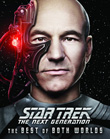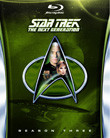A few weeks ago CBS invited TrekCore to talk with the CBS Digital team responsible for the wondrous restoration and remastering of Star Trek: The Next Generation in high definition. Craig Weiss and his team were very generous with their time and answered a huge number of questions, often very technical in nature. I hope you enjoy the resulting interview and leave with a greater understanding and appreciation for the monumental effort that this project represents, and of the wonderfully talented people who are working tirelessly behind-the-scenes to make it happen. Feel free, as usual, to leave comments and questions below.
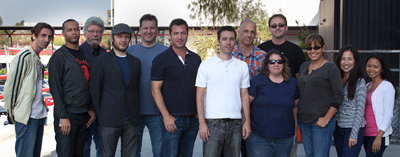
CBS Digital: TNG Remastered Interview, Part 3
Interviewed by Adam Walker for TrekCore.com
![]()
TrekCore: Do you find that moving between the different seasons, there are different technical challenges? Is there a different film stock used for different seasons?
Wendy Ruiz: The quality of the film does change a little bit between Season 1 and Season 3. In Season 1 the material generally had a lot more grain (and it was a different DP) than we are noticing now in Season 3. So far, for Season 3 [the film has] been in a lot better condition than Season 1.
Craig Weiss: I can’t speak specifically, but I know they did change film-stocks – they got better, because when they used the higher ASA [film speed] stocks, if they didn’t have enough light it would get grainy. And I know as time went on, the stocks got better which reduced the amount of grain – as Wendy was saying – and the color looks better, and it improves throughout the seasons.
TrekCore: So we can look forward to future seasons being even better quality than the first season?
Craig Weiss: Yes
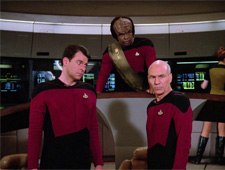 |
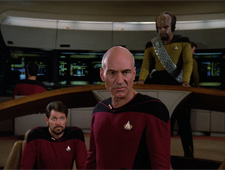 |
| Between seasons, the film stock often changed resulting in differing grain textures and overall appearance. Season 1 (left – ‘The Neutral Zone‘) has a vibrant, almost glossy look compared to Season 2 (right – ‘Q Who‘) which is quite matte and more cinematic. | |
TrekCore: How often is the color correction applied? Do you have a fixed calibration that you use? Or is it different from dark and bright scenes? Are scenes individually adjusted based on their exposure?
Wendy Ruiz: All of the above. We do apply definite color correction to every single episode. We spend anywhere from … I want to say 2 to 3 days… on color correction alone. Again, trying to stay true to the story, the scene, whether it’s a darker episode, whether it’s a brighter happier episode. The bridge we’re trying to maintain consistent color throughout. As far as individual scenes, it depends on which episode it is. If it’s a darker mood, then we honor that.
Eric Bruno: And also our film technicians, for example, always use the chip charts with the film, which are basically color and gray-scale charts which tell you what the color and luminance should be. So that’s always our starting point, to match what the DP’s [Director of Photography] original intention is. And on top of that, as Wendy just mentioned, the mood of the episode, the notes, all that kind of stuff [is taken into account] to get the final color. And often we’ll get an artistic interpretation from one of our artists as well.
Wendy Ruiz: We have Mike and Denise Okuda present, reviewing every single episode. They give us guidance – especially story-wise, to make sure we are true to the story.
TrekCore: Once the whole project is finished, presumably there’s going to be a lot more uniformity between the episodes, rather than – at the moment on the DVDs – some episodes are completely washed out, some are oversaturated, some have a weird hue to them…
Wendy Ruiz: That’s what we’re hoping for, yes.
Eric Bruno: I can speak from the visual effects side, with the ship shots. My goal is to keep as much consistency between the ships as possible except when story tells you otherwise.
TrekCore: Moving on to the new [planet] effects, a question for Max Gabl. We’re assuming the effects are done in the pixel domain – what’s the preferred resolution you are working with?
Max Gabl: We’re trying to keep it all in HD, 1920 by 1080 and then we’re cropping on both sides. Unless there’s a planet where we have several angles, you know – the same planet, where several sections are shown. I’m trying to cover the whole thing, and then I render one planet in high resolution and cut out whatever is needed. But most of the time with these direct shots, it’s all HD.
TrekCore: I know we saw a few of the preview images from Season 1 which appeared to be in a widescreen aspect ratio. Do you render in widescreen?
Max Gabl: Yes, I render them in 16:9 widescreen HD. Even though we’re going to crop them on both sides to 4:3, it never hurts to have a little more to use, we can move left or right and do a little adjustment.
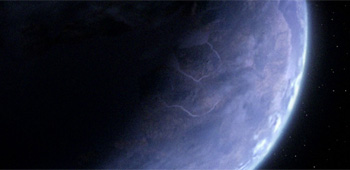
Most of the Season 1 planets (including Delphi Ardu IV, above) were recreated in CG by Max Gabl. Max renders his planets in 16:9 widescreen HD. They are then cropped to fit the scene.
TrekCore: Apart from the pilot episode where you were able to reuse matte paintings from Deneb IV, have all the planets been CG recreations?
Max Gabl: I think most of them are total recreations. Because the planets we’re looking at from the original [TNG] series are very low-res and blurry. There’s no way to put more detail into those, so it’s basically all recreation. Mike Okuda tells us exactly what we need in there, and it’s just back and forth – playing it and seeing what the details are going to look like and then I put them in, compare with the old, [Mike will] look at it, I’ll make the changes and that’s how it goes.
TrekCore: Do you have a personal favorite you’ve made so far?
Max Gabl: Not really, I mean – I like most of them. I don’t have a personal favorite. Maybe Vulcan, that’s a nice one to do – it’s a famous planet, so there are expectations and I put in a lot more detail, and that’s one I really enjoyed doing.
TrekCore: Do you make complete maps of the planet, or do you just make a map of the side we will see on the screen?
Max Gabl: They are all rendered in 3D, I use a 3D application. I put the textures around a 3D sphere that rotates, then add an extra layer for clouds that also rotates at a different speed. They are all coming out in 3D now. Once the textures are around the planet, I do a test view, and then change the lighting, a lot of tweaks. So that’s all in 3D now.
TrekCore: With regards to matte paintings of planet surfaces and other shots, do they always hold up in high definition or do they sometimes have to be enhanced so you have to make them look less like two-dimensional paintings?
Max Gabl: Sometimes they hold up, but I would say most of the time they need some recreation to be a little more realistic. We add some more detail in.
TrekCore: Do you know if any of the CGI footage that was originally created in The Next Generation has survived. I know you beautifully recreated the Crystalline Entity in Season One, but with regards to the other shots, is that all lost?
Niel Wray: No, nothing.
Wendy Ruiz: No
Niel Wray: Anything which was originally done in CG, we have to recreate in CG.
TrekCore: Are there cases where effects which were made pretty easily back in the 80s and the 90s using practical effects techniques are now more complicated to render using todays CGI?
Niel Wray: In some cases, yes – in some cases, no, but in a lot of cases yes. It’s pretty challenging to recreate some of those original optical elements in CG.
TrekCore: Could you give us a few examples?
Craig Weiss: Any kind of organic elements which were shot…
Niel Wray: Yes, the transporter we had to recreate the elements for that. And that took us a few weeks to recreate those elements. How many layers to that? Yes, there are 3 layers to that.
Eric Bruno: Any of the elements, as Craig mentioned, that are more organic, that are more random … random textures, random chaos, lasers – like the Calamarain – laser aliens… you have lights shooting through smoke with some sort of cloth in front of it with a light on it, you know there are several layers of physical objects they are filming and they are doing camera tricks to it too. To recreate that, as Niel will tell you, is a LOT of work!
TrekCore: So is the only option there CGI recreation, or do you have the option to film those effects using the original practical techniques?
Eric Bruno: Actually, that’s a good question. There is an element…
Wendy Ruiz: Replicator
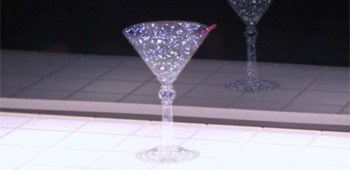
CBS-Digital found a novel way to recreate the replicator visual effects when they were remastering Star Trek: The Next Generation Season 1 into HD.
Eric Bruno: Replicator, you know where you make all the food. We were creating that element, and through some research we found out it was basically a tube of water with sparkles in it swirled around. So we went on to our stage and got a big giant vase, filled it with water, bought a bunch of sparkles from a local store and we shot it! That’s what we’re using for all the replicator shots. Our new shot isn’t CG, it’s faithful to how they did it 25 years ago.
TrekCore: That is fantastic – you must do it as a bonus feature, we’d all love to see how that’s done!
Laughter

